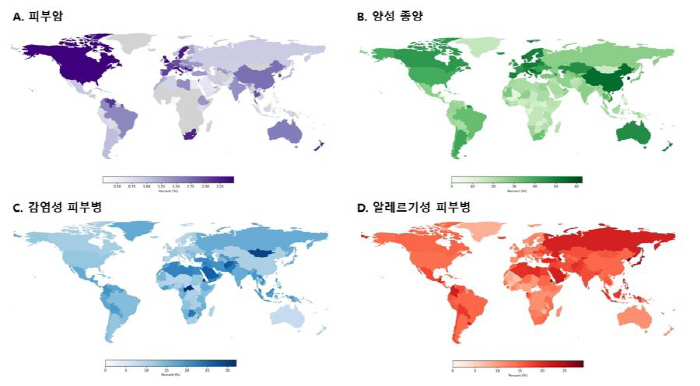A real-time map of skin diseases around the world has also been released…Complementing the Limitations of the International Surveillance System
|
While even the World Health Organization (WHO) is unable to clearly compile statistics on skin diseases by country, this is the first time that skin disease patterns around the world have been analyzed and visualized with real-time data.
A research team led by Professor Na Jeong-im of the Department of Dermatology at Seoul National University Bundang Hospital (first author Han Seung-seok, Eye Dermatology) visualized the global usage records of its own skin disease AI algorithm 'ModelDerm' through the real-time aggregation platform (https://stat.modelderm.com ) so that anyone can check them.
The platform shows users' reading records of various skin diseases such as skin cancer, benign tumors, gum mushrooms, mantises, and follicles over the past month, and is automatically updated every hour.
Real-time statistics released in this map are likely to be used as new public health indicators as they can show not only the current status of the incidence but also what skin diseases patients in each region are interested in in in real time.
Existing international health monitoring systems, such as the WHO, only count some of the skin diseases, such as skin cancer and atopic skin, and it took up to several years to update the data, making it difficult to grasp the detailed status of each region in real time. This achievement is drawing attention in that it is the first attempt to overcome these limits.
The research team analyzed the model performance based on Korea's large-scale clinical data (150,000 cases) and ModelDerm's global actual use data (1.69 million cases), and recorded 78.2% of sensitivity (probability to accurately identify cancer) and 88.0% of specificity (probability to correctly identify people without cancer) in skin cancer diagnosis, showing high accuracy.
In addition, skin cancer is relatively common in North America (2.6%), benign tumors are prominent in Asia (55.5%), and infectious diseases are prominent in Africa (17.1%), showing similar results to previous studies and epidemiological surveys in regional distribution by disease, confirming that it can be used as meaningful data.
Professor Na Jeong-im said, "This achievement suggests that by accurately collecting and analyzing data from AI diagnostic solutions, the current status of skin diseases by country can be shown in real time, such as the 'weather forecast'" It will contribute to identifying and responding to global skin disease trends faster by providing information that the existing global health monitoring system cannot contain."
The study was conducted in cooperation with nine domestic universities, the Swiss University of Basel, and the Catholic University of Chile, and the results of the study were published in the latest issue of the international journal 『Nature Partner Journal Digital Medicine』 (IF:15).
Meanwhile, ModelDerm is an AI algorithm developed by Dr. Han Seung-seok in 2017, which finds relevant skin disease information with very high accuracy when uploading pictures of skin lesions. It is available for free through a mobile app and is the most widely used among global skin disease AI solutions. The number of users amounts to 1 million in 228 countries worldwide.
|
This article was translated by Naver AI translator.





